Dopamine Core Bedroom Ideas: Design Your Happy Place
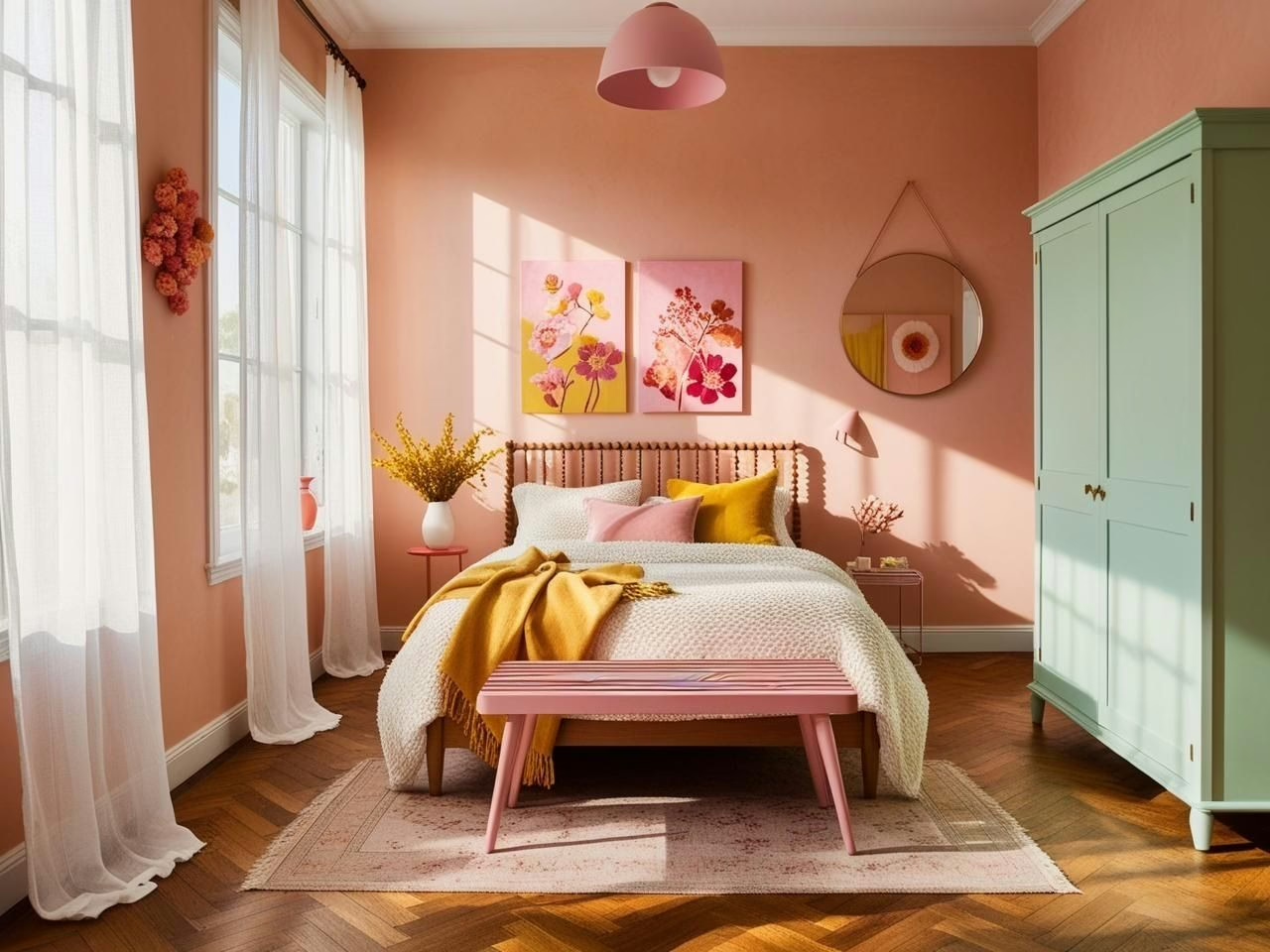
Let’s cut the fluffy design speak and get honest about what’s actually happening in your bedroom. Not that kind of happening (though good design might help there too) – I’m talking about the neurochemical party that’s either raging or completely dead depending on your design choices.
That “calming” all-white bedroom you’ve been drooling over on Instagram? It might actually be depressing your brain. Those seventeen decorative pillows arranged just-so? Your dopamine receptors couldn’t care less about them. And that “relaxing” blue paint color that every design blog recommends? It might be putting you to sleep – but not in the good way.
Here’s the truth that most design magazines won’t tell you: your bedroom isn’t just a place to display your excellent taste – it’s a neurological environment that actively shapes your mood, sleep quality, and yes, happiness levels. The dopamine core approach isn’t about chasing the latest color trend; it’s about understanding how your specific brain responds to visual, tactile, and functional elements.
The good news? You don’t need an interior design degree or trust fund to create a space that makes your brain chemistry sing. You just need to understand a few fundamental principles about how your nervous system actually responds to your environment – and then have the courage to ignore some design “rules” that might be standing between you and genuine bedroom happiness.
So let’s skip past the generic design fluff and get into what actually matters for creating a bedroom that doesn’t just look good in photos but actively makes your brain happier to exist in it.
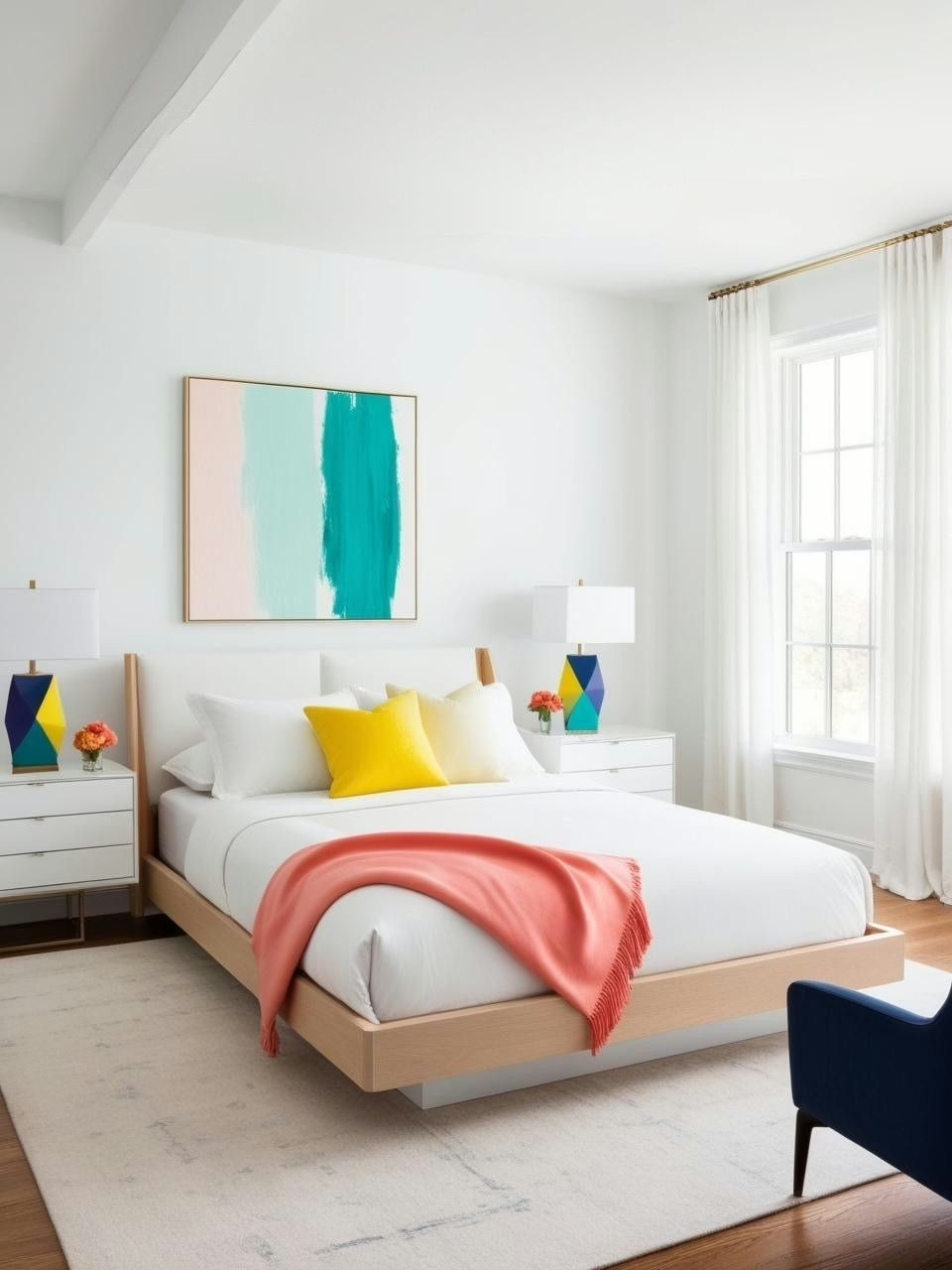
Color Psychology That Boosts Dopamine in Your Bedroom
Let’s cut through the design magazine nonsense and talk about what actually makes your brain chemistry happy—not what makes for a good photo shoot.
Beyond the Blue-is-Calming Cliché
We’ve all heard the same tired advice: blue calms, green refreshes, blah blah blah. But here’s what they don’t tell you: generic color advice is about as useful as a chocolate teapot. Your brain has a unique relationship with color based on your personal history, cultural background, and yes, even your childhood bedroom wallpaper.
The most dopamine-triggering colors in your space won’t come from a trending palette—they’ll come from tapping into your personal color history. That specific shade of orange that reminds you of your best summer vacation? That’s dopamine gold, even if no designer would recommend it.
Strategic Color Mapping
Not all bedroom surfaces deserve equal color treatment. Here’s where your dopamine-boosting colors actually belong:
- Ceiling: The most underrated color opportunity in your entire bedroom. A deep, rich color overhead creates the sensation of being embraced rather than exposed.
- Behind the bed: Your peripheral vision catches this area every morning—make it count with something that perks up your brain.
- Avoid: Statement walls directly across from your bed that you stare at while trying to fall asleep—they become attention vampires when you need to wind down.
The Unexpected Color Combinations That Actually Work
The most stimulating spaces don’t follow standard color wheel rules—they create unexpected tensions your brain finds intriguing:
- Mustard + Plum: The contrast between warm and cool creates visual tension your brain finds deliciously interesting
- Terracotta + Navy: Earth tones grounded with deep saturation signal both comfort and depth
- Sage + Rust: The natural complementary relationship triggers primitive pleasure responses
Color Reality Check:
- Your partner doesn’t care about your design vision if they hate the color—find dopamine triggers you both respond to
- Don’t paint directly from tiny swatches—your brain processes small and large color fields completely differently
- That white bedroom that looks amazing on Instagram? It’s probably been edited and is actually cream or greige in real life
Remember: the colors that trigger genuine joy aren’t the ones currently trending on design blogs—they’re the ones that make YOUR specific neural pathways light up with recognition and pleasure. Your dopamine response is personal, not universal.
Your Shortcut to Effortless Mid-Century Modern Style
12 refined color palettes & implementation strategies designed to bring sophistication, texture, and harmony into your home.
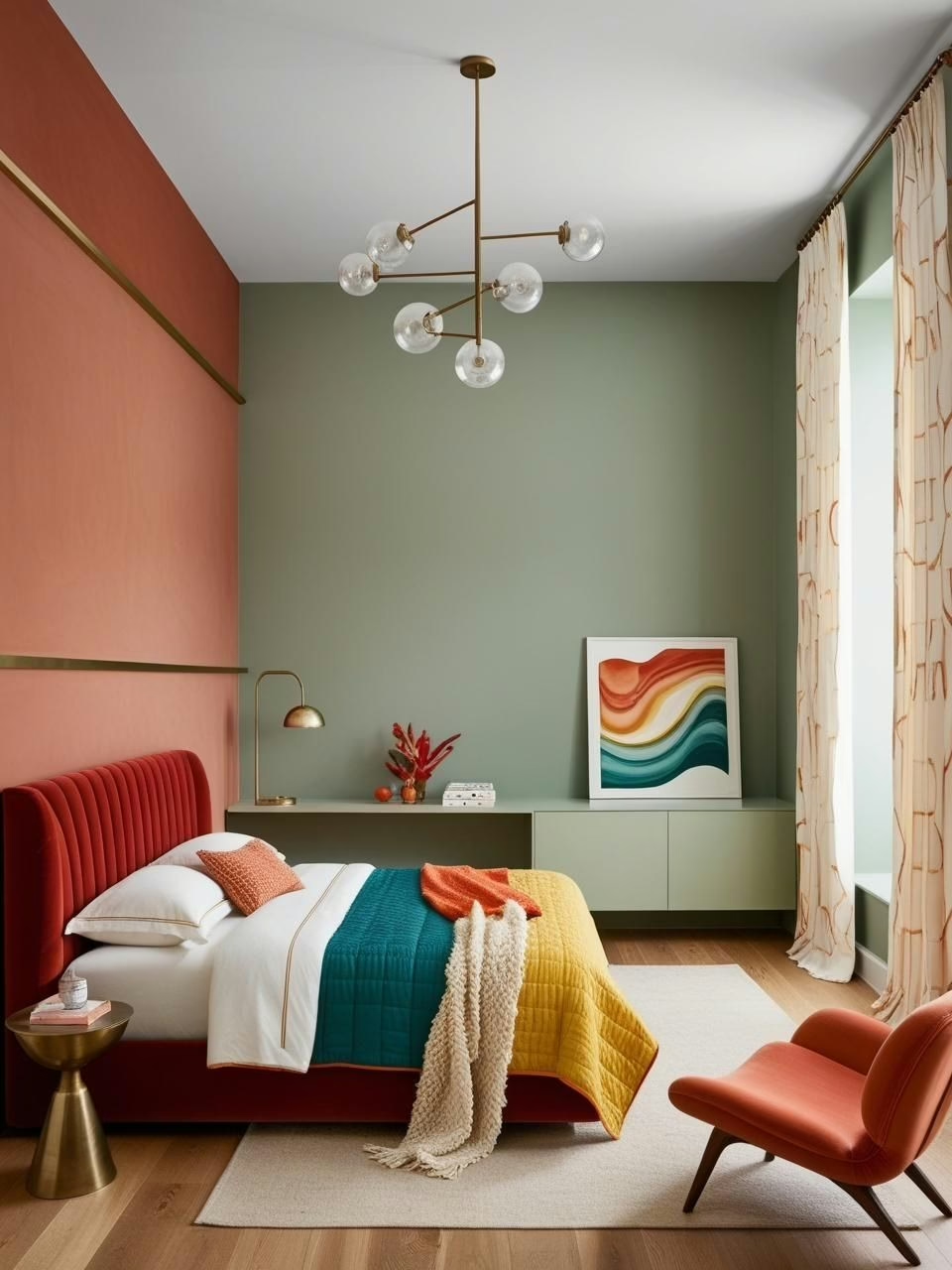
Dopamine Core Bedroom Ideas: Texture Pairings That Wake Up Your Brain
If colors feed your eyes, textures feed your fingertips. And let’s be honest—your bedroom should be a full-sensory experience, not just a visual showcase for your Instagram stories.
The Touch Test That Most Designers Skip
Here’s the brutal truth about bedroom design: if something feels awful to touch, your brain won’t care how pretty it looks. That velvet pillow that feels like sandpaper? Your neurons are screaming every time you brush against it.
The real dopamine triggers happen when you actually interact with your space—not just look at it. That’s why the best designers don’t just select fabrics from tiny swatches; they rub them against their cheek. Yes, actually. Try it next time you’re fabric shopping and watch the sales associate pretend not to notice.
Contrast Pairings That Wake Up Your Brain
Your fingertips get bored with sameness just like your eyes do. The magic happens when you create deliberate texture contrast:
- Smooth + Nubby: Think silk pillowcases against a chunky knit throw—your fingers get a little thrill from the transition
- Soft + Structured: Plush bedding against the firm edge of a wooden nightstand creates sensory boundaries your brain loves
- Warm + Cool: The temperature contrast between a cool metal lamp base and warm woolen throw triggers multiple sensory receptors
The Bedding Layers That Actually Work
Let’s cut through the 12-pillow bedscape nonsense. Your dopamine receptors (and morning routine) need simplicity with targeted impact:
- Base layer: 100% cotton percale or linen sheets that breathe—because nothing kills joy faster than night sweats
- Middle comfort: A coverlet with actual textural interest, not just a visual pattern
- Top layer: One—yes, ONE—throw blanket with exceptional tactile quality that makes your fingers happy every time you touch it
- Pillow reality: Two sleeping pillows you actually use + one accent pillow with extraordinary texture—not the decorator’s dozen that ends up on the floor
The Weighted Touch Hack
The science is clear: gentle pressure triggers serotonin and dopamine release. But weighted blankets aren’t your only option:
- A heavy knit throw delivers similar benefits with better breathability
- Doubled-up duvet inserts in just one quadrant of your comforter—right where your torso lies
- Textured wallpaper that gives your palms something interesting to feel as you pass by
Remember: textures that photograph well aren’t necessarily textures that feel good. Your fingertips have opinions too, and they’re directly wired to your brain’s reward center. Let them vote on your design decisions.
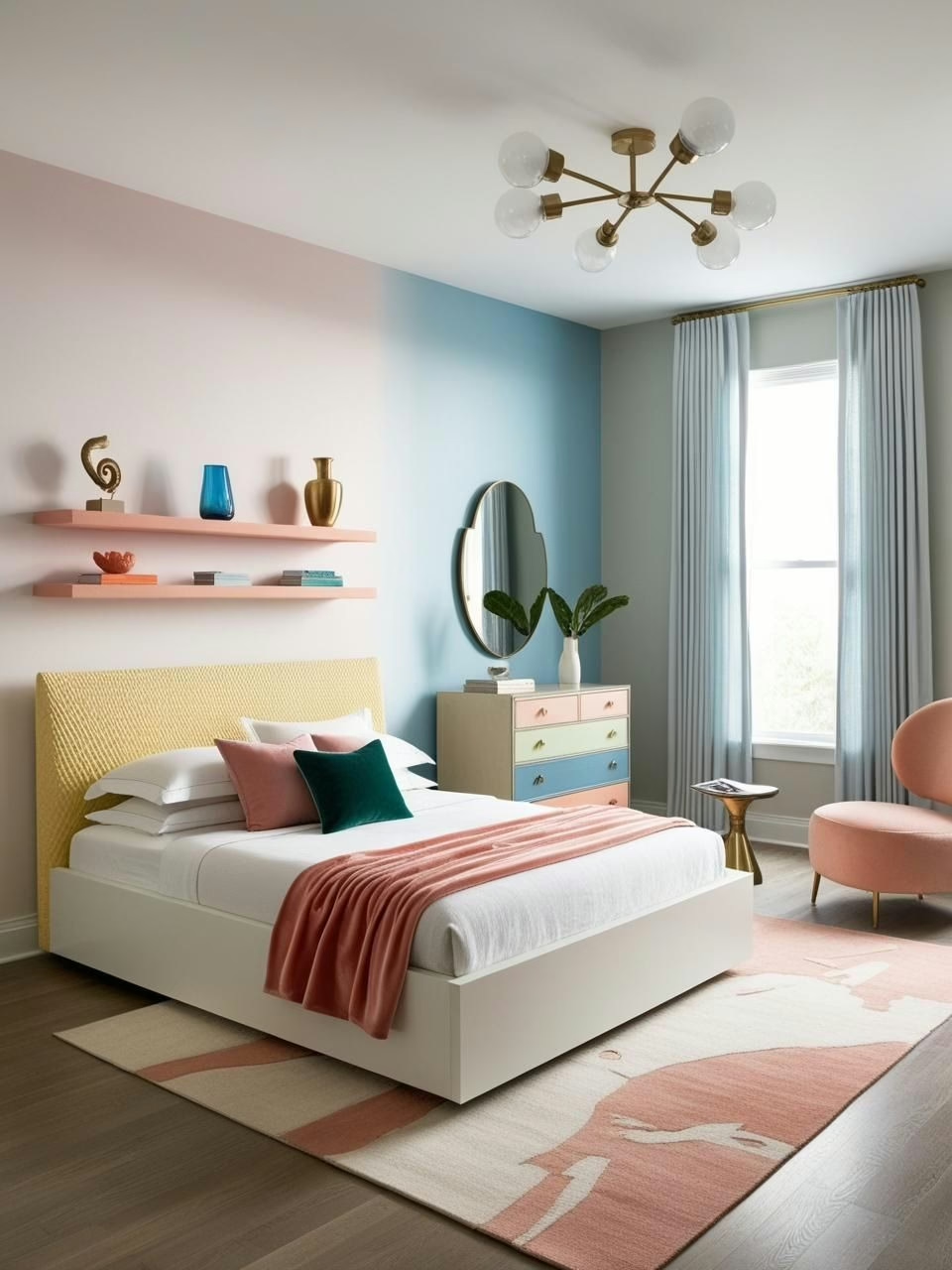
Lighting Hacks That Support Dopamine and Sleep Cycles
Forget everything you think you know about bedroom lighting. That single overhead fixture isn’t just ugly – it’s actively sabotaging your brain chemistry.
The Morning Dopamine Trigger
Your brain evolved under the sun, not a sad 40-watt bulb from Target. Here’s how to hack your lighting for genuine morning happiness:
- Color temperature matters: 5000K+ bulbs in your morning zones trigger the same brain response as actual sunlight
- Placement beats brightness: A light source that hits your retinas from above and slightly to the side mimics natural dawn light
- First light ritual: Position a lamp with a timer within arm’s reach of your bed—warm light for the first 5 minutes, then gradually increasing brightness and cooler temperature
The real dopamine hack? Programmable bulbs that transition from warm evening light to energizing morning light without you needing to remember to flip a switch. Your primitive brain can’t tell the difference between a smart bulb and the actual sun rising.
The Evening Wind-Down Lighting Truth
That blue light from your phone isn’t the only thing keeping you up. Your bedroom lighting is probably working against your sleep chemistry:
- The red shift: Bulbs under 2700K trigger melatonin production – install them in bedside lamps
- Dimmer reality check: Most LED bulbs flicker when dimmed, causing subtle eye strain your brain registers as stress
- The 3-2-1 rule: Three light sources, two brightness levels, one warm color temperature after 8pm
The Lighting Zones No One Tells You About
Your bedroom isn’t one space – it’s multiple micro-environments that deserve different lighting treatments:
- Dressing area: The brutal truth about your outfit doesn’t shine through until you see it in proper color-rendering light (90+ CRI bulbs)
- Bedside reading: Downward-directed light that doesn’t spill into your partner’s space
- Ambient corners: The often-forgotten mood builders that create depth perception and reduce the “hospital room effect”
The Harsh Reality About Most Bedroom Light Fixtures
That statement chandelier looks great on Pinterest but delivers terrible actual light. The truth:
- Most decorative fixtures prioritize looks over light quality
- Your brain registers shadows and uneven lighting as potential threats
- Uplighting creates the most natural-feeling illumination (bounce light off ceilings and walls)
Remember: your pineal gland doesn’t care how trendy your light fixture is – it responds to specific wavelengths and directions of light that trigger real neurochemical responses. A designer might sell you on a gorgeous sconce, but your dopamine receptors are more interested in the bulb inside it.

Dopamine Core Bedroom Decor: Personal Joy Anchors
Let’s be brutally honest – those artfully arranged bedroom vignettes you see in magazines are usually filled with meaningless junk nobody actually cares about. Your dopamine receptors aren’t fooled by generic “decorative objects” that could be in anyone’s home.
The Memory Station Revolution
Forget the staged bookshelf styling. Your brain craves authentic connections to positive experiences:
- The visual time capsule: A concentrated display of 3-5 objects that transport you to specific happy memories beats a dozen forgettable trinkets
- The sensory shortcut: Items that activate multiple senses simultaneously trigger stronger dopamine responses (the shell that smells like beach vacation, not just looks like one)
- The morning glance spot: Position your most joy-inducing items where your eyes naturally land first thing upon waking
The trick isn’t more stuff – it’s fewer things with deeper personal resonance. That mass-produced “inspirational” wall sign from HomeGoods? Your brain cells are actually rolling their eyes at it.
The “Joy Density” Formula
Quality over quantity isn’t just good design – it’s good neuroscience:
- High density: One incredibly meaningful object surrounded by negative space generates more happiness than six moderately meaningful objects clustered together
- Rotation system: Keep 70% of your joy triggers displayed and 30% stored, then swap monthly to prevent hedonic adaptation (when your brain stops noticing things that stay the same)
- Height prioritization: Items at eye level get 3x more neural attention than items placed too high or too low
Art That Actually Matters
The wall art in most bedrooms is about as emotionally meaningful as elevator music. Your dopamine system deserves better:
- The oversized personal photo: That sunset shot from your favorite vacation, blown up to 30×40, will trigger more genuine joy than any mass-produced canvas art
- The color memory link: Art containing colors tied to specific positive memories creates a neurological shortcut to pleasure
- The rotation commitment: Even beloved art becomes neurologically invisible after 90 days – set a calendar reminder to swap pieces quarterly
The Clutter-Joy Paradox
Here’s the inconvenient truth: what looks “minimal and serene” in photos often feels sterile and depressing in real life. Your brain needs some visual stimulation to feel alive:
- Most minimalist inspiration images are actually styled with careful asymmetry that looks “clean” but provides subtle visual interest
- Your dopamine system responds more positively to organized abundance than stark emptiness
- Personal meaning trumps design principles every single time
Remember: your bedroom doesn’t need to impress hypothetical house guests with its style cohesion. It needs to make YOUR specific brain light up with recognition, comfort, and genuine pleasure. That weird little souvenir that makes no design sense but reminds you of your best day ever? Give it pride of place.
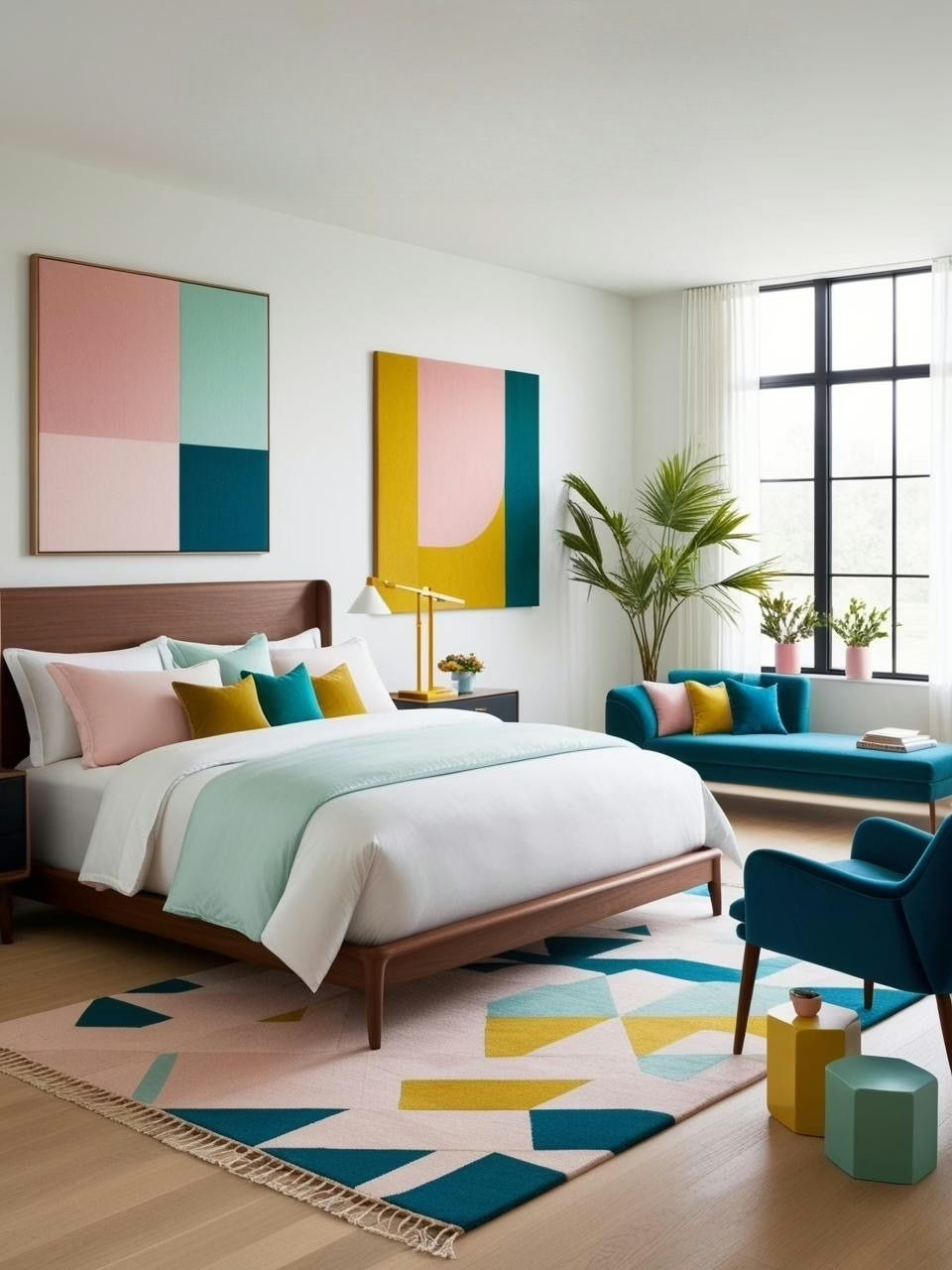
Dopamine Core Bedroom Ideas That Actually Work for Real Life
Let’s get painfully honest about bedroom functionality – that gorgeous bedroom setup with the decorative ladder and artfully draped throw? Probably hasn’t housed an actual human being who needs to get dressed at 6am on a Monday.
Designing for Your Actual Morning Routine (Not Your Fantasy Self)
That Pinterest-perfect bedroom with seventeen pillows and a bench covered in decorative objects? It’s the bedroom equivalent of buying size-too-small jeans as “motivation.”
Your dopamine system doesn’t respond to aspirational design – it responds to spaces that actually make your real life easier:
- The true morning path: Track where you actually walk in those first groggy moments and keep that route obstacle-free (no cute pouf positioned exactly where your feet need to go)
- The clothing reality: If you dress in your bedroom, you need a dedicated spot for tomorrow’s outfit that isn’t “draped over the chair under three other things”
- The morning bottleneck: Identify what slows you down each morning and design a specific solution for it – even if it breaks conventional styling rules
The brutal truth? A functional bedroom that supports your actual habits will make you happier than a showpiece bedroom that fights against your real behavior patterns every single day.
Non-Negotiable Comfort Zones
Some bedroom spaces matter exponentially more than others for your brain chemistry:
- The bed approach: The last 3 feet of space you navigate before collapsing into bed should be free of both physical and visual obstacles
- The waking view: What you see in the first 30 seconds after opening your eyes disproportionately affects your mood for the next 4 hours
- The getting-ready space: Where you transform from sleeping human to functioning adult deserves intentional design, not just “whatever space is left”
The Maintenance-to-Joy Ratio
Here’s the design truth no one wants to admit: If it’s a pain to maintain, it won’t make you happy, no matter how good it looks on Instagram.
The maintenance reality check:
- That white duvet cover looks dreamy but requires weekly washing to stay that way
- Open shelving displays require consistent dusting and curating
- Any system requiring more than 10 seconds to maintain will eventually be abandoned
Your dopamine receptors don’t respond to how your bedroom looked on installation day – they respond to how it looks on random Tuesday mornings. Design for that reality instead of the photoshoot fantasy.
The Partner Compromise That Actually Works
The fastest way to kill bedroom joy? Ignoring the needs and preferences of everyone who sleeps there. The solution isn’t bland neutrality – it’s strategic zoning:
- Create clearly delineated “yours” and “theirs” areas where individual preferences reign supreme
- Identify the 3 non-negotiable elements for each person and build around those
- Focus shared elements on tactile pleasures you both enjoy, even if your visual preferences differ
Remember: a bedroom that looks perfect but feels uncomfortable is a dopamine desert. Your brain doesn’t care what the room looks like in photos – it cares how the space makes you feel when you’re actually living in it. That’s where the real happiness chemicals start flowing.
Unlock Designer-Perfect Colors in Minutes
Browse my curated collection of interior color palettes—tailored for today’s most loved design styles.
Conclusion: Your Dopamine Bedroom Reality Check
Let’s wrap this up with some uncomfortable truths about creating a genuinely happiness-inducing bedroom.
That picture-perfect bedroom on your mood board? It’s probably never housed an actual human being who drools occasionally, keeps a half-drunk water glass on the nightstand, and sometimes flings clothes onto the nearest surface. Real dopamine-triggering design isn’t about creating a showpiece—it’s about creating a space that actually supports your messy, imperfect human existence.
The Real Dopamine Formula
The science is clear: your brain doesn’t get happy because your bedroom follows design rules or current trends. It gets happy when:
- Your senses are pleasantly stimulated (not overwhelmed or underwhelmed)
- Your daily functions are supported rather than hindered
- Your personal memories and preferences are honored
- Your space feels like it was designed for YOU, not for hypothetical house guests or Instagram followers
The Brutal Final Truth
The most beautiful bedroom in the world won’t make you happy if you can’t maintain it, can’t afford it, or don’t actually feel comfortable in it. Your dopamine receptors don’t care about your design inspiration board—they care about how your actual, lived experience feels within the space.
So go ahead and paint that ceiling the weird color that makes you smile. Keep that oddly-shaped souvenir from your best vacation where you can see it. Create morning rituals that your bedroom design actually supports instead of fights against.
Because at the end of the day (literally), a bedroom that makes your brain chemistry happy isn’t about following design rules—it’s about breaking them in exactly the right ways for your specific neural pathways. That’s the real dopamine core revolution.
Curated Wall Art for Elegant Homes
Bring softness, texture, and intention into your home with digital wall art inspired by wabi-sabi, abstract forms, and muted watercolors. Every piece is crafted to create stillness and beauty—whether you’re styling a gallery wall or a minimalist nook.